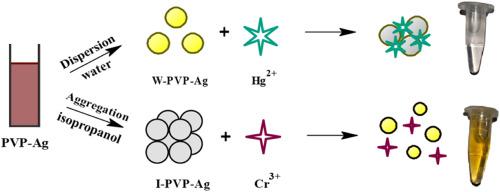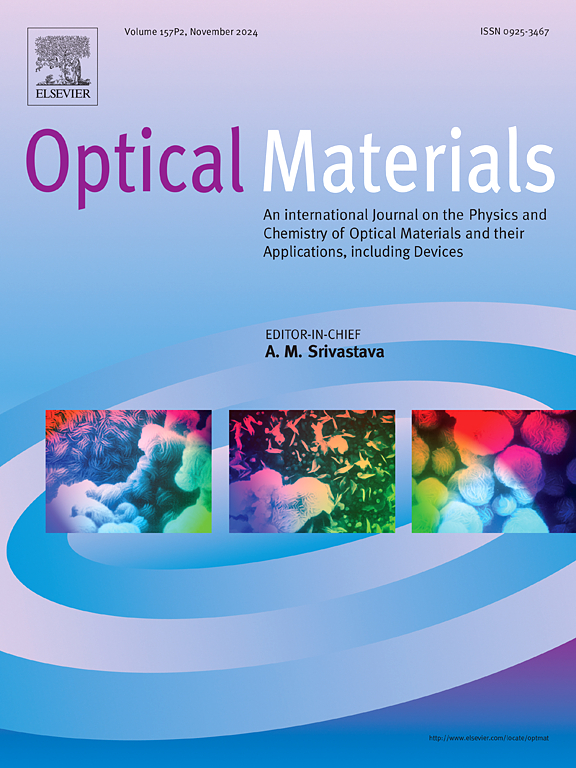用聚乙烯吡咯烷酮稳定银纳米粒子作为比色传感器,基于溶剂对 Hg2+ 和 Cr3+ 离子进行双重检测
IF 3.8
3区 材料科学
Q2 MATERIALS SCIENCE, MULTIDISCIPLINARY
引用次数: 0
摘要
聚乙烯吡咯烷酮(PVP)稳定银纳米粒子(PVP-Ag)可用于检测 Hg2+ 和 Cr3+ 离子,通过改变稀释溶剂,改变材料的局部表面等离子体共振(LSPR)吸收带,形成黄色和无色纳米粒子。黄色 PVP-Ag 纳米粒子在 410 纳米波长处出现吸收峰。该探针与 Hg2+ 离子相互作用后,吸收峰的强度下降,颜色也明显从黄色变为无色。无色透明的 PVP-Ag 没有吸收峰,但加入 Cr3+ 离子后会在 440 纳米波长处出现吸收峰,因此在相互作用后会产生黄色。TEM、DLS 和傅立叶变换红外光谱结果表明,材料与 Hg2+ 和 Cr3+ 相互作用后,粒子间的距离发生了变化,从而导致 Hg2+ 和 Cr3+ 的检测。Hg2+ 和 Cr3+ 的检测限(LOD)分别为 2.2 nM 和 50.9 nM。本文章由计算机程序翻译,如有差异,请以英文原文为准。

Solvent-based dual detection of Hg2+ and Cr3+ ions by polyvinylpyrrolidone stabilized silver nanoparticles as colorimetric sensor
Polyvinylpyrrolidone (PVP)-stabilized silver nanoparticles (PVP–Ag) are utilized for the detection of Hg2+ and Cr3+ ions by varying the diluting solvents, which alters the material's local surface plasmon resonance (LSPR) absorption band, forming yellow and colorless nanoparticles. Yellow PVP-Ag nanoparticles exhibit an absorption peak at 410 nm. This probe interacts with the Hg2+ ions, as a result, the intensity of the absorption peak drops, and the color changes noticeably from yellow to colorless. The colorless transparent PVP-Ag exhibits no absorption peak; however, adding Cr3+ ions causes a peak at 440 nm, thus producing a yellow color after the interaction. The TEM, DLS, and FTIR results show the interaction of materials with Hg2+ and Cr3+, which results in the change of inter-particle distance, leading to the detection of Hg2+ and Cr3+. The limits of detection (LOD) for Hg2+ and Cr3+ were determined to be 2.2 nM and 50.9 nM, respectively.
求助全文
通过发布文献求助,成功后即可免费获取论文全文。
去求助
来源期刊

Optical Materials
工程技术-材料科学:综合
CiteScore
6.60
自引率
12.80%
发文量
1265
审稿时长
38 days
期刊介绍:
Optical Materials has an open access mirror journal Optical Materials: X, sharing the same aims and scope, editorial team, submission system and rigorous peer review.
The purpose of Optical Materials is to provide a means of communication and technology transfer between researchers who are interested in materials for potential device applications. The journal publishes original papers and review articles on the design, synthesis, characterisation and applications of optical materials.
OPTICAL MATERIALS focuses on:
• Optical Properties of Material Systems;
• The Materials Aspects of Optical Phenomena;
• The Materials Aspects of Devices and Applications.
Authors can submit separate research elements describing their data to Data in Brief and methods to Methods X.
 求助内容:
求助内容: 应助结果提醒方式:
应助结果提醒方式:


